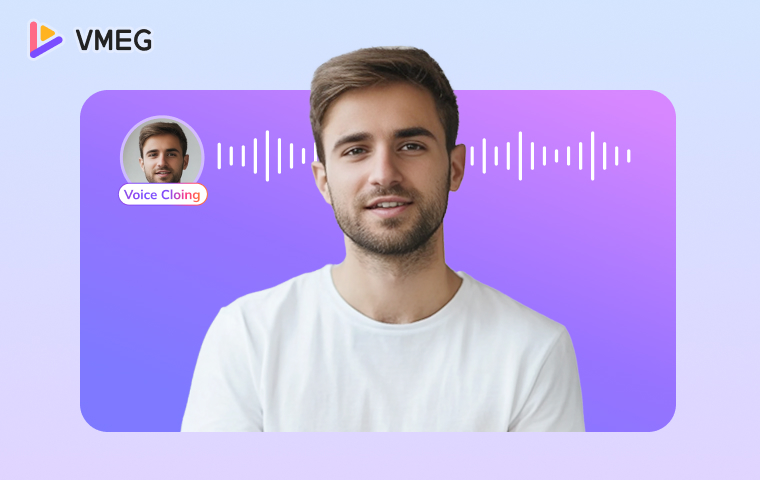
Translating your video into multiple languages no longer requires expensive studios or hours of manual editing. Thanks to improvements in AI, video translation apps now allow creators, educators, and corporations to make dubbed or subtitled videos with lip-sync, voice cloning, and emotion-aware speech in only a few clicks.
This guide will look at the top 7 AI video translator solutions in 2025. Whether you're a YouTuber looking to reach a global audience, a company making multilingual training films, or a teacher localizing e-learning content, these tools will help you get your message across.
What Is an AI Video Translator?
An AI video translator is a tool that uses artificial intelligence (AI) to transform the audio and/or on-screen text from one language to another. These tools automate the process of making video material available to worldwide audiences by eliminating the need to hire translators, voice actors, or editors manually.
Depending on the app’s features, a video translator can:
Generate subtitles in multiple languages
Dub audio using realistic AI voices or cloned versions of the original speaker
Synchronize lip movements with translated speech (lip-sync)
Preserve voice tone, emotion, and identity with voice cloning technology
Most of them are web-based and require no technical skills. You simply upload your video, choose a target language, and let the tool handle the translation, dubbing, and subtitle generation.
What Makes a Great AI Video Translator?
Before introducing specific tools, let's understand the key features of a good AI video translator and the problems it can solve:
Language & Voice Support: Broad support for global languages and diverse voices.
Voice Cloning: Can the tool retain or replicate the original speaker’s voice? You need to consider.
Lip-Sync Accuracy: Does the mouth movement match the dubbed audio?
Ease of Use: Fast, intuitive workflows and browser-based access. This is important to beginners.
Pricing: Flexible plans that fit individuals and teams.
Now, let’s dive into the top tools that check these boxes.
7 Best AI Video Translators in 2025
Looking to break language barriers and reach a global audience? These 7 AI-powered video translator apps offer cutting-edge features like voice cloning, lip-syncing, and multi-language dubbing—perfect for creators, educators, and businesses in 2025.
1. VMEG AI – Best All-in-One AI Video Translator for Creators & Businesses
Supported platform: Web-based, with no need to download any software.
VMEG AI is a comprehensive AI-powered video localization platform that offers automatic dubbing, multi-language subtitle translation, voice cloning across global languages, and post-processed lip-sync — all within a user-friendly browser interface. It's the only localization solution that supports voice cloning for virtually every major language, making it a standout tool for creators, educators, and businesses aiming to scale their global content without compromising quality.
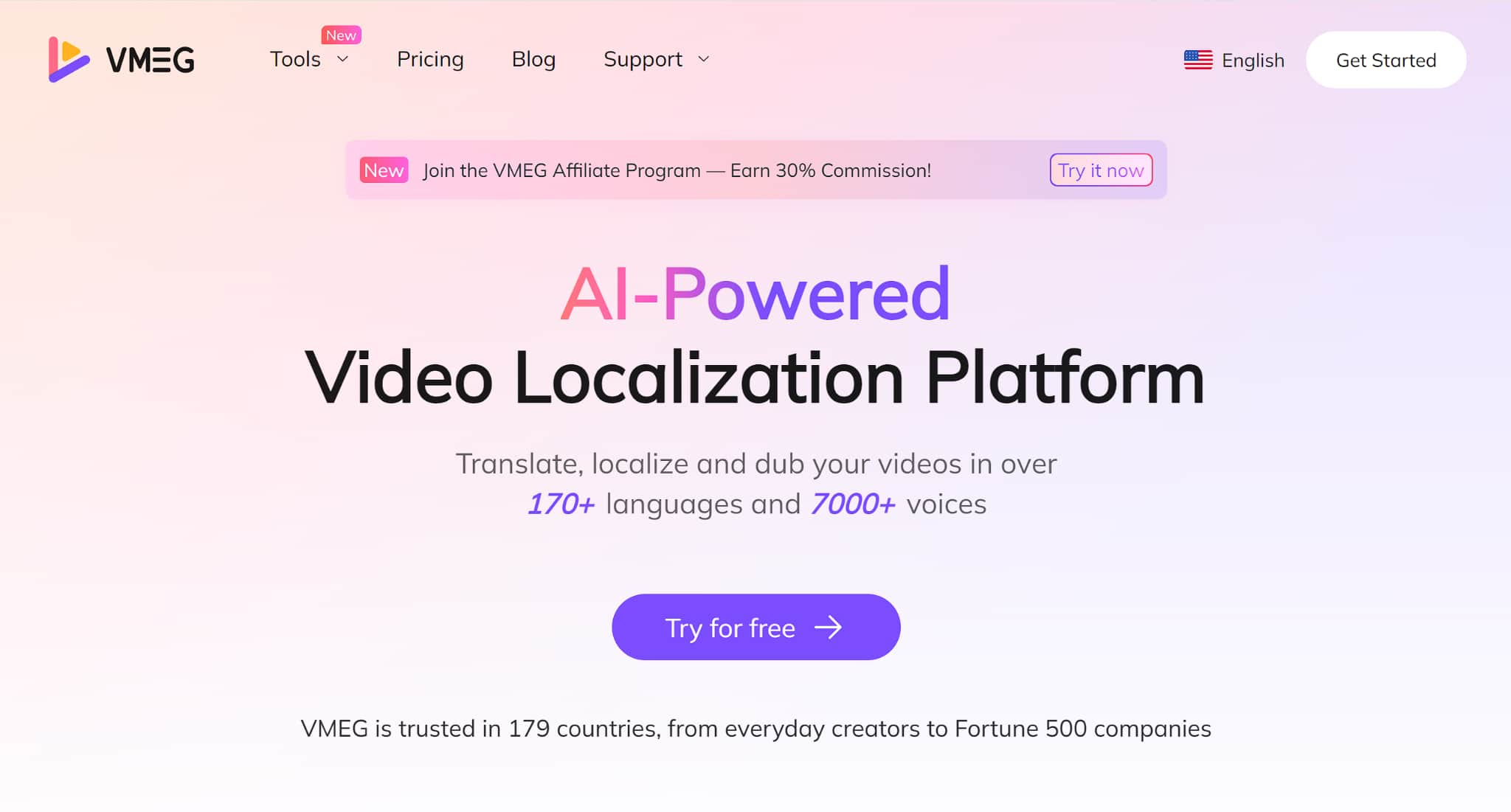
Key Features:
Supports 170+ languages and 7,000+ AI voice styles, so you can translate your video and audio content easily.
Post-process lip-sync that aligns facial movements with translated audio before export.
Subtitle Translator - translates video subtitles into other languages.
Unlimited voice cloning, preserving the speaker’s tone and emotion.
Convert video and audio content into text, with support for exporting in multiple formats. You can also paste a YouTube URL to transcribe the content.
Best For: Content creators, YouTubers, e-learning professionals, marketing teams, agencies
Pricing:
Free trial with 60 credits
Studio Plan: $25/month (600 credits)
Pay as you need: start from $12/240 credits
Enterprise pricing available for bulk needs
Pros:
High-quality lip-sync and emotional voice dubbing
Easy-to-use editor with timeline and preview tools
Fast turnaround (videos processed in minutes)
Cons:
Requires internet connection (cloud-based only)
May need export credits for longer projects
Real User Review:
“I'll leave you with a video explaining the importance of statistics. I used an artificial intelligence app called VMEG to add Turkish subtitles to this video. The app also offers video translation, dubbing, and many other features. 📊Finally, let's not forget: Statisticians don't overwhelm the world with data; it makes sense.”
“This is how you solve a translation issue for a video where the presenter speaks in Spanish, but you need it to be in English. Thanks to AI, many things have become easier—one of the most important for me is that it can be done in a short time. This is what we’re presenting today as part of the content we at Neouranus are developing for the competitive expedition taking place at the end of this month in Morocco.”
2. HeyGen

Features:
175+ languages and dialects with emotion-rich voice options
Realistic lip-sync for real people and avatars
Built-in video editor with AI avatars if needed
Cloud-based with fast rendering
Best For: Businesses, marketers, and YouTubers seeking realistic multilingual content
Pricing:
Free plan: 3 Avatar IV Videos
Creator: $29/month
Business: $39/seat/month
Pros:
Excellent lip sync with avatars or real footage
Supports team collaboration
Cons:
Time limits on free/creator plans
Voice cloning accuracy may vary per speaker
Real User Review:
One user from r/generativeAI said:
“I like the platform, but their customer service sucks. If you have any videos stuck in the ‘rejected’ section it's tedious AF. AND THEY NEVER RESPOND. And if they do respond, they obviously ignore half of what you told them. So useless.”
Chaaritha Dheerasinghe from Trustpilot said:
“As a video editor for a digital solutions company, I was able to successfully make a number of short corporate videos using HeyGen's collection of avatars and its most basic monthly plan. It also has a feature that enables the synching of a pre-recorded audio narration with a given avatar, which is quite great when you need to do a video in a regional language not supported by language settings.”
3. Rask AI
Rask is a fast-growing video localization platform that specializes in multilingual dubbing, transcription, and subtitle generation. What sets it apart is its highly accurate voice cloning engine, which lets you maintain the identity of the original speaker—even in a different language. That makes Rask particularly appealing to brands, media teams, and educators who need to keep consistency across regional markets.
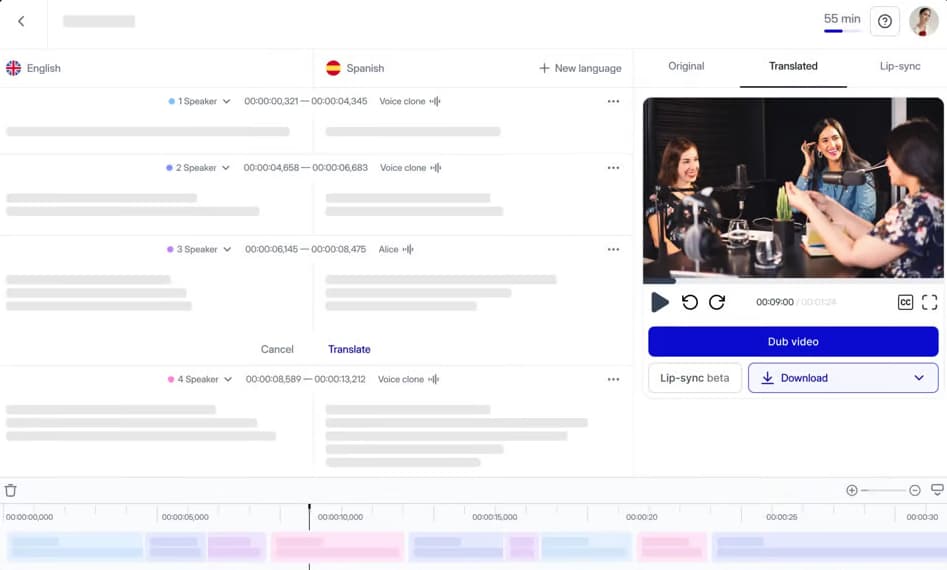
With support for over 130 languages and features like automatic subtitle syncing, multi-speaker handling, and brand voice preservation, Rask delivers a powerful solution for scaling your content internationally.
Key Features:
130+ languages
AI voice matching to the original speaker
Ideal for enterprises that need localization at scale
Supports both audio dubbing and subtitle workflows
Offers robust user collaboration and review tools
Best For: Media teams, e-learning platforms, international marketing
Pricing:
Basic: $60/month for 25 mins
Pro: $150/month for 100 mins
Business: $750/month for 500 minutes included
Pros:
Great balance of speed and quality
Detailed subtitle timeline control
Advanced voice cloning
Cons:
No visual lip-sync animation
Expensive for individual creators
Real User Review:
Wave from Trustpilot said:
“Really impressive, I use it to translate my videos into different languages and it works really well, but you'll have to learn how to use it properly, and sometimes the voice is out of sync with the video, so it's up to you to adjust this when editing, so apart from being a bit complex, the tool works really well! (opinion in a professional context)”
4. Synthesia
While widely used by corporate teams, HR departments, and e-learning providers for creating branded training or communication content, it's worth noting that Synthesia was not originally built for video translation. Its audio and subtitle translation features are secondary add-ons, and may lack the depth and precision found in tools specifically designed for AI dubbing or voice localization.
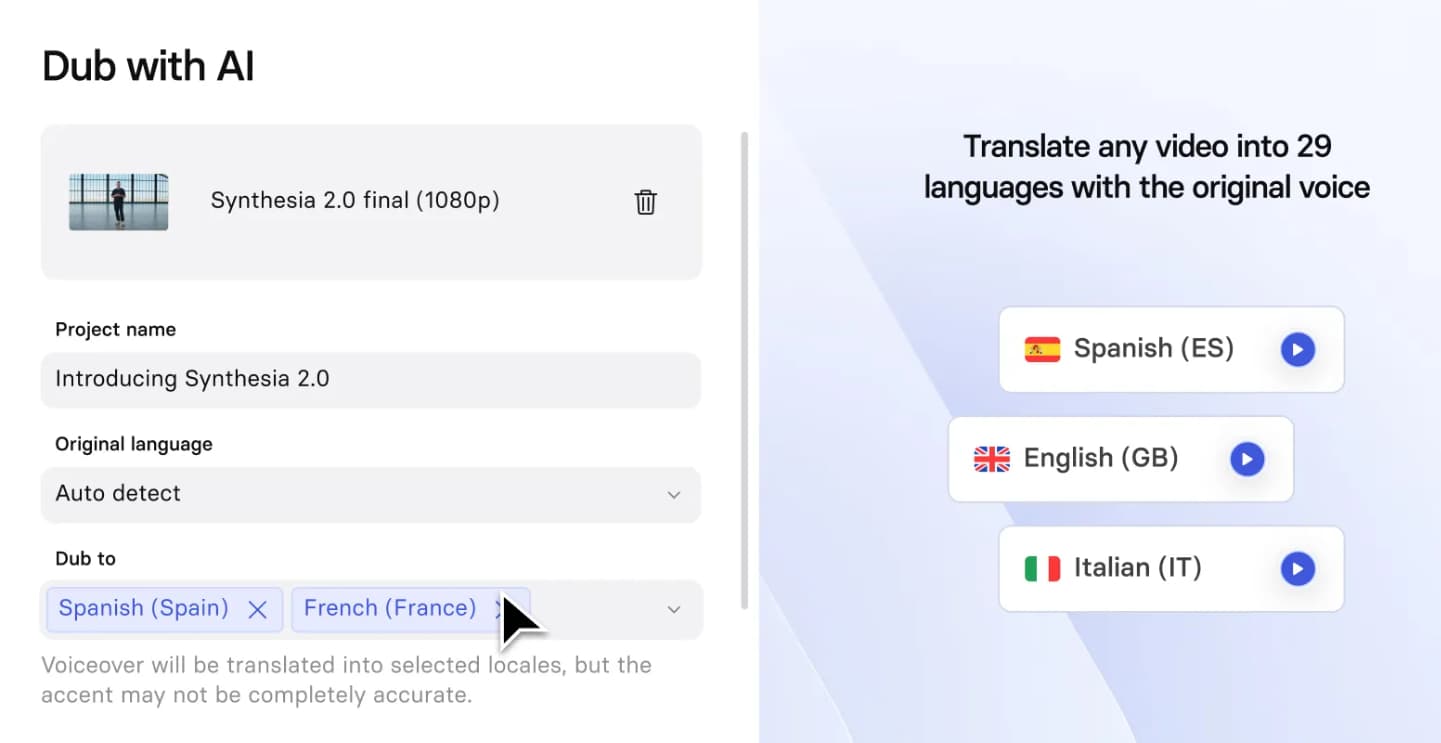
Why Synthesia stands out:
140+ languages, 120+ realistic avatars
Great for creating training, onboarding, and explainer videos
Simplifies content production with text-to-video workflow
Consistent, polished aesthetic for branded communication
Best For: Corporate training, internal comms, explainer videos
Pricing:
Starter: $29/month (10 minutes of video/month)
Creator: $89/mo (30 minutes of video/month)
Enterprise: Custom
Pros:
High-quality avatar lip-sync
Multilingual support
Great for formal/business content
Cons:
A little expensive for personal users.
Real User Review:
Movement Fitness from Product Hunt said:
“Very labor intensive to use, too much time and video quality is meh. Monthly Pricing sign up is only certain length videos so you are able to see the finished version for review in the monthly membership.”
RC from Trustpilot said:
“Synthesia makes creating high quality videos very easy. It has a great selection of avatars, settings, voices and templates. It is enhanced further with the AI option for creating your video.”
5. Veed.io
However, VEED’s core strength lies in video editing, not translation—its dubbing and localization features are relatively lightweight and may not offer the accuracy or customization needed for professional multilingual content.

Features:
Subtitle generation & translation
125+ different languages
Voiceover from text
Trim, cut, merge tools
Best For: Social media creators, podcasters, marketers
Pricing:
Free plan (watermarked)
Basic: $19/month (Automatic subtitles:144 hours/year)
Pro: $49/month, Translate videos into over 50 languages (4 hours/year)
Pros:
Fast subtitle editing
Easy-to-use editor
Works well for short videos
Cons:
No voice cloning or lip-sync
Limited dubbing quality
Real User Review:
Pamela W from Capterra said:
“I use Veed nearly every day and am happy as it helps mainily with shorts. Pros: It is best to do shorts with subtitles. Easy to use. Cons: The translation could be improved, as it sometimes doesn't translate correctly.”
6.Kapwing
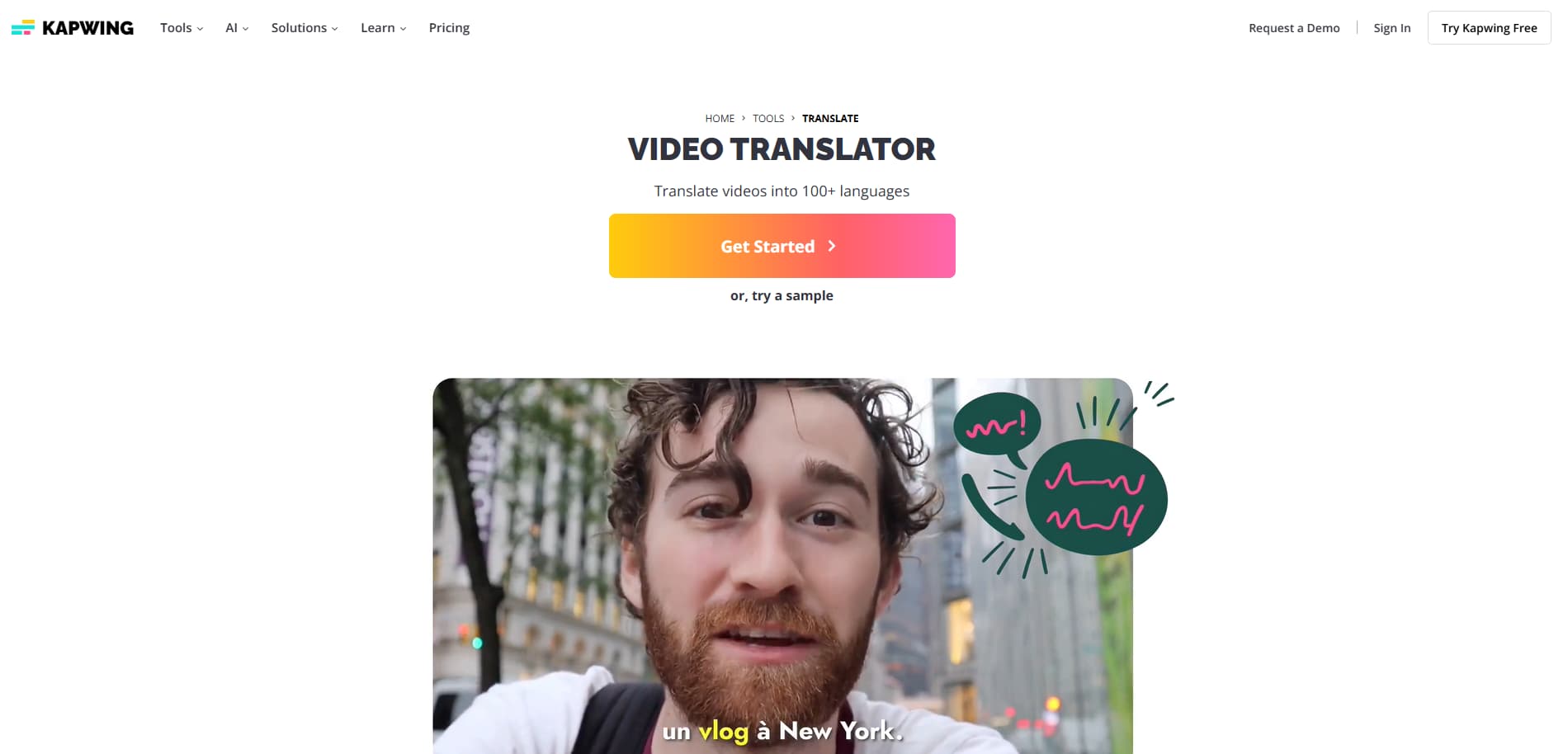
Features:
Text-to-speech voiceovers
Subtitle translation
70+ languages
Drag-and-drop interface
Best For: TikTokers, educators, bloggers
Pricing:
Free plan (basic features)- Generate up to 2 minutes of standard Text to Speech per month
Pro: $24/month- Translate videos up to 300 mins per month
Business: $50/month- Translate videos up to 900 mins per month
Pros:
Accessible and fast
No installation needed
Free tier available
Cons:
No voice cloning
Lacks accurate lip-sync
Real User Review:
Eldar from Software Advice said:
“The tool helps to create subtitles for a video automatically, with AI it detects the words of the person in the video and writes what he is saying, and it can be done with several languages including automatic translation into a different language from the one heard in the video. but you still have to check the subtitles boxes and fix the mistakes of the AI, any way it saves you time with the subtitles placing job on the video timeline.”
7. Maestra
Maestra is an AI-powered dubbing and subtitle generation platform designed for educators, content creators, and global marketing teams. It offers fast and accurate auto-subtitling, voiceover translation in 60+ languages, and easy team collaboration tools—all accessible through a clean, browser-based interface.
While Maestra doesn’t offer the ultra-realistic voice dubbing of enterprise-focused tools like Papercup, it excels at speed, accessibility, and affordability. It's a great choice for small teams and creators who need reliable multilingual support without technical complexity.
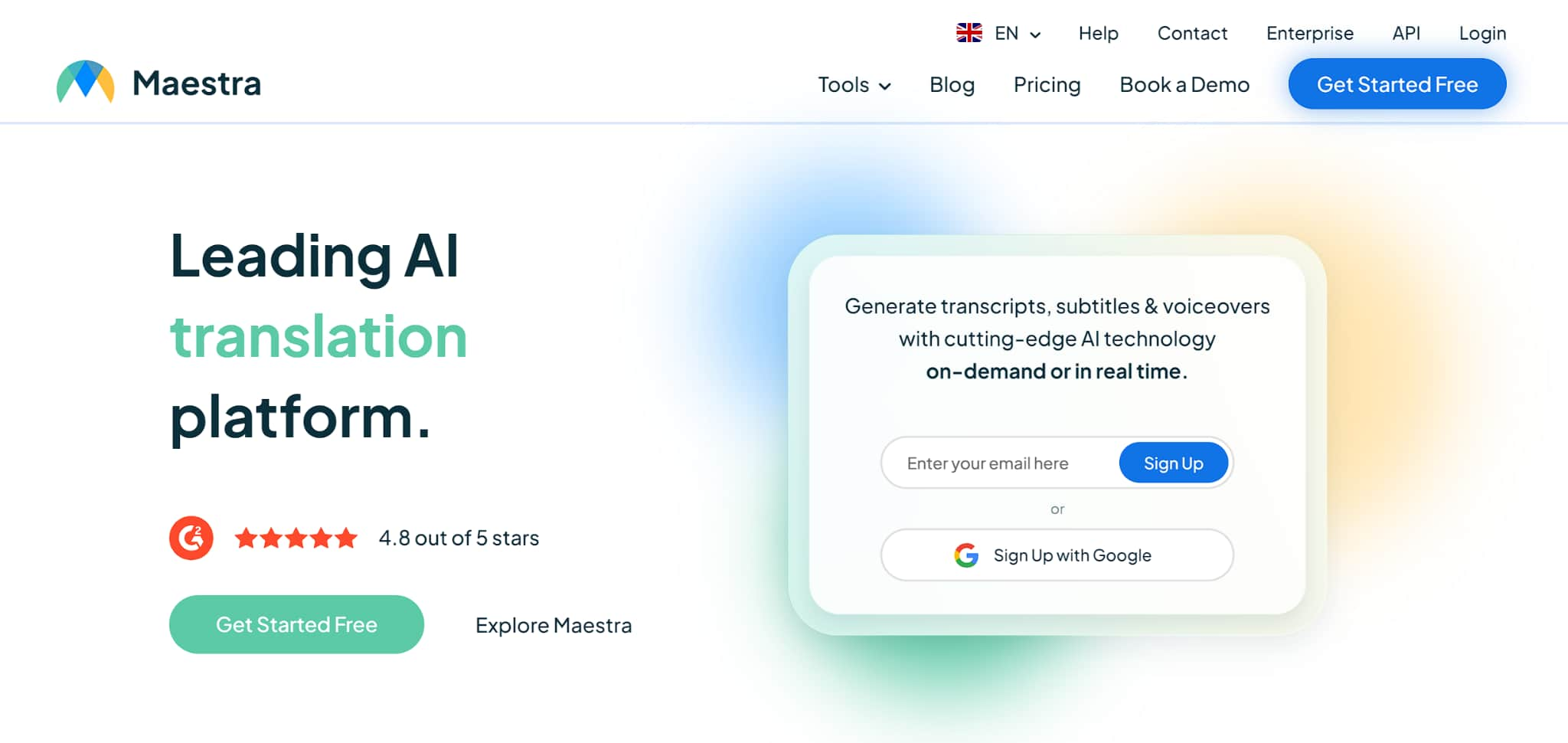
Why Maestra stands out:
Automatic subtitle generation and translation
Voiceover dubbing in 60+ languages using AI-generated voices
Built-in collaboration tools for teams and clients
No software installation required—entirely web-based
Also supports audio/video transcription and exports
Best For: Educators, course creators, marketing teams, and small businesses
Pricing:
Starter: $29/month (180 minutes)
Pro: $49/month (360 minutes)
Premium: $99/month (900 minutes)
Enterprise: Custom pricing for larger teams and bulk translation needs
Pros:
Multilingual subtitle and voiceover support
Easy collaboration and user sharing
Fast transcription and dubbing for audio/video content
Cons:
Voice output may lack human-like emotion
No lip-syncing or voice cloning functionality
Real User Review:
Felipe L. from G2 said:
“We used Maestra to localize a marketing campaign into 5 languages, and it worked like a charm. Easy to use, affordable, and the turnaround was fast. I’d love to see more realistic voice tones in the future.”
Comparison Table of Top Video Translator Tools
| Platform | Languages & Voices | Voice Cloning | Lip-Sync Support | Pricing |
|---|---|---|---|---|
| VMEG AI | 170+ languages, 7,000+ voices with emotional tones | ✅ Unlimited voice cloning | ✅ High-precision visual lip-sync | From $12.5/month |
| HeyGen | 175+ languages, 300+ voices (incl. avatars) | ✅ Clones speaker's tone & emotion | ✅ Advanced visual lip-sync | From $29/month |
| Synthesia | 140+ languages, 230+ avatars | ⚠️ Limited (Enterprise only) | ✅ Avatar-only lip-sync | From ~$30/month |
| Rask AI | 130+ languages, customizable voices | ✅ Brand-level voice cloning | ⚠️ Audio sync only, no lip re-animation | From $60/month |
| Papercup | ~70+ languages, broadcast-quality AI voices | ✅ Emotionally natural dubbing | ⚠️ Audio-only sync, no lip animation | Enterprise pricing |
| VEED.io | 100+ languages, standard TTS voices | ❌ No voice cloning | ❌ No lip-sync | From $18/month |
| Kapwing | 70+ languages, basic TTS voice options | ❌ No voice cloning | ❌ No lip-sync | Free plan, Pro from $24/month |
Conclusion
AI video translation apps have come a long way, allowing anyone to turn a monolingual video into a multilingual masterpiece—with minimal effort. Whether you're localizing YouTube content, training staff across regions, or marketing globally, the right AI tool can save you hours and elevate your content.
Among all, VMEG.ai stands out with its combination of voice cloning, accurate lip-sync, subtitle generation, and broad language support—making it a top choice for creators and enterprises alike.
